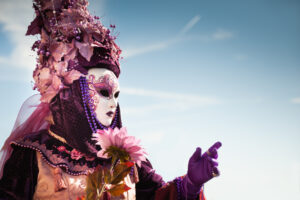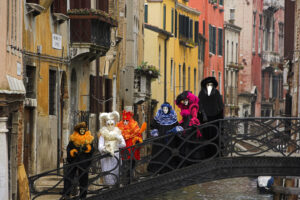By Francesca Montillo, ISDA Food + Travel Writer
You’ve seen images of it, and perhaps, you’ve been intrigued by it all. The masks and millions of people, the spectacle and overindulgence, but what exactly is Venice Carnival? Let’s get to know this age-old, pre-Lent mega party a little bit better.
Exploring the history of Venice Carnival and its curiosities means embarking on a journey into the habits and customs that reigned centuries ago in Italy. Venice has celebrated Carnival sporadically since 1162 AD (having just claimed victory over the Patriarch of Aquileia, Venetians took to the streets in celebration).
The origin of Carnival dates to the Middle Ages. It appears for the first time in a document by Doge Vitale Falier in 1094 AD, when the idea of public entertainment was first mentioned. Two very ancient traditions were also rooted in the festival: Rome had the Saturnalia, a festival during which the social order was overthrown by its residents. On this day, enslaved people and free citizens flocked to the city to celebrate with music and wild dancing. Meanwhile, the Greeks had the Dionysian cults, i.e., large religious festivals with processions and theatrical performances involving masks and symbolic representations. The motto was “once a year, it is acceptable to have no brakes or restrains.” Venetians, therefore, reinterpreted the ancient Greek and Roman festivals (in 1162). Carnival became “official” in 1296 when a mandate by the Senate of the Republic declared the day before the start of Lent a public holiday.

The Doges (who ruled Venice from 697 AD to 1797 AD) promoted Carnival to grant the population, particularly the humbler classes, a period dedicated to revelry and celebrations. In Venice Carnival, masks guaranteed total anonymity. A sort of cancellation of social divisions allowed citizens to deride the authorities and the aristocracy publicly. This celebration represented an outlet for the tensions and discontent created due to the rigid limits imposed by the morality and public order of the Republic of Venice.
The Return of Carnival
In 1979, after almost two centuries in purgatory, Venice Carnival, with its otherworldly traditions, rose like a phoenix from its ashes, thanks to the initiative of some citizens’ associations and the contribution of the Municipality of Venice, the Teatro la Fenice, the Venice Biennale, and tourist authorities.
The current Venice Carnival has become a significant and spectacular tourist event, attracting millions of visitors from all over the world. Tourists flock to the city to participate in this festival, considered unique for its history and accoutrements.
Carnival generally lasts 11 days, from the Saturday preceding Fat Thursday until Fat Tuesday (Feb. 13). Traveling theaters take place in the city streets in an atmosphere of joy and playfulness, with everyone in masks to celebrate the charm of a world with dances, comedy, exclusive galas, and romantic encounters.
Traditions: Eccentric and Spectacular
Traditional events include the Feast of the Maries, the Flight of the Angel, or the Flight of the Colombina. The ancient Feast of the Maries, reinstated in 1999, consists of the twelve Maries parading on the afternoon of the first Saturday of the Carnival, complete with flag-wavers, musicians, and bridesmaids, all heading toward Piazza San Marco. Subsequently, the most beautiful one is selected as “Maria of the Year,” and wins a monetary prize. The Flight of the Angel or Flight of the Colombina is held on the first Sunday of Carnival. It is one of the central opening events. A mechanical dove descends from the Campanile of San Marco to the Palazzo Ducale. Halfway through, a trap door in its belly opens and releases confetti and sweets onto the crowd. This was the tradition until 2001 when a suitably harnessed woman replaced the dove.

Masks were always crucial to Venetians. Over the centuries, they were permitted to wear them from the day after Christmas until the day before Ash Wednesday. Also worn during other times of the year, it wouldn’t be unheard of for Venetians to wear masks for upwards of six months of the year! Masks permitted the generally reserved and “high society” Venetians to partake in risky business, such as gambling or mingling with the other classes. Masks took people out of character and allowed them to become someone else, if only for a little while.
Plan Your Trip to the Carnival
There certainly isn’t a lack of entertainment in Venice during this time. St. Mark’s Square becomes a festive and joyous piazza filled with locals and tourists wearing masks and costumes. Food stalls commonly sell local items such as the famous peach Bellinis to frittelle, or fried dough.

Many events are family-friendly and free to participate, while some require tickets and an admission fee. Many parades include children dressed as cartoon characters. Music festivals fill the streets, and “invite-only” masquerade balls are common. The Carnival ends with spectacular fireworks on Shrove Tuesday, and Venice slowly returns to everyday life.
If you’re like me and plan on adding Carnival in Venice to your bucket list, be sure to plan ahead. Hotels book early as this is their peak season. And the events that require tickets usually sell early and fast. Many masquerade balls can be costly to attend, but numerous hotels host their own masquerade balls, so this may be a great option. You can rent the fancy dress-up gowns, though I advise buying a mask and keeping it as a souvenir.
Make a pledge and become a member of Italian Sons and Daughters of America today.


